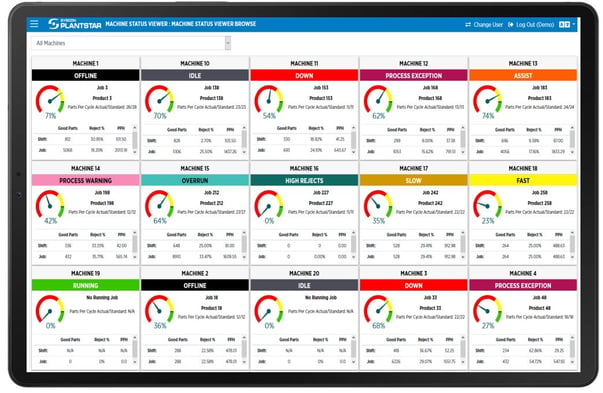SYSCON PlantStar BLOG
How to Increase Manufacturing Efficiency Without Buying More Machines
Oct 16, 2020 9:00:00 AM / by David Crowley

As 2020 winds down, the global manufacturing industry faces the harsh truths of a “new-normal” outlook as the COVID-19 pandemic continues to grow. A shrinking workforce, chaotic technological disruption and tighter globalized competition have forced companies to sharpen their lean production strategies and do more with less. While many manufacturers have found ways to maintain efficiency during the pandemic, others struggle to address rapid demand growth.
In the realm of machine upkeep and maintenance, plant managers face a real juggling act – a stronger demand for robust output coupled with shrinking capital budgets for equipment. A recent report by Manufacturing notes:
“New order intakes rose at the quickest pace in almost two-and-a-half years, boosted by the first increase in international goods trade since August 2018.”
“The largest opportunity is focusing your efforts on improving overall equipment effectiveness,” said Jeff Shiver of Reliable Plant. Indeed, factories can deploy a number of tactics to improve manufacturing efficiency across the entire machine/equipment spectrum.
By leveraging proven lean manufacturing principles, project management pros can reduce downtime and wasted time and proactively manage equipment failures before they affect productivity. The result? Increased production output, which leads to higher revenue and growth in customer satisfaction. The journey begins by identifying bottlenecks. By untangling them, manufacturers can embrace the optimization of available materials, preventative/predictive maintenance and a renewed sense of employee engagement.
Identify Bottlenecks
In much the same way the neck of a bottle of ketchup or salad dressing slows down how much and how fast the contents can flow, bottlenecks stifle the flow of throughput across your plant’s manufacturing systems and process – especially as applied to your shop floor’s machine configuration.
Often, however, managers experience difficulty identifying the source of the bottleneck. Is it being caused by a specific machine? A previously unidentified defect or breakdown? Plant managers need to need to know everything that’s happening with production activities and process variables.
Deploying a Manufacturing Execution System (MES) will fuel robust data collection and analysis and that maximizes overall equipment effectiveness and sky-rockets potential. Next-level MES solutions employ cutting-edge tech to provide everything from drag-and-drop job scheduling to real-time dashboard reporting and customizable alerts, taking the guesswork out of bottleneck detection.

In terms of machine efficiency, an MES quickly identifies sources of downtime, targets repeated issues, which allows managers to determine if there are specific factors that repeatedly cause problems. Since buying new machinery may not be a realistic goal, an MES can measure real-time OEE on existing machines, giving manufacturers actionable insight before investing in new machines.
MES solutions like PlantStar 4.0 broadcast alerts when machines go down while maintaining a record of each occurrence. The system tracks the top causes of downtime for each machine and displays the percentage of time taken up by each down.
Having that level of insight at your fingertips improves operator tracking and training, often resulting in more than 50-percent savings in operator training costs. By integrating the tools available in a superior MES, managers experience faster time-to-value – in some cases, as much as six-figure in savings via optimized capacity. In short, real-time data drives proactive action.
Make the Most of Your Materials
Manufacturing waste refers not only to energy, workforce-hours and space but also (and especially) materials.
There are several proactive steps managers can immediately take to curtail raw materials waste. For example, using less material from the start by employing more accurate parts design or finding new uses for excess materials.
As noted above, enhanced collection and analysis of production data provides the magic key to optimizing every process, including scrap reporting and improved recycled materials management. By understanding the amount and type of wasted materials, managers can determine if recycled materials should be used in a new process or be sold to another factory. Suddenly, waste transforms into profit.
MES solutions like PlantStar provide material and tool tracking modules that empower managers to see the status of materials used in specific machines while allowing new insights on when the materials need to be replenished or when equipment needs maintenance. PlantStar’s extremely detailed data insights reduce the manual labor necessary to gather these details.
Preventative and Predictive Maintenance
“An ounce of prevention is worth a pound of cure” is definitely a cliché. But cliches are … well…cliches because they are generally on point. The best way to stop a future machine slowdown is via pinpoint preventative maintenance coupled with dedicated predictive maintenance.
Nothing decimates revenue more than machine breakdown. It grinds the entire manufacturing process it a profit-stealing halt. A 2020 Aberdeen Group report pegged the average cost of unexpected machine downtime at $260,000 per hour.
Spending time and money on preventative maintenance can seem cost-prohibitive since the process is future-facing rather than a short-term, “here-and-now” benefit. However, creating and maintaining a serious PM schedule keeps machines running smoothly and consistently.
Forward-thinking manufacturers are increasingly seeking Internet of Things solutions to predict future issues. Manufacturing IoT advances predictive maintenance across the shop floor by leveraging sensors, data visualization, remote tools and insights via artificial intelligence.
PlantStar’s MES system simplifies both preventative and predictive scheduling with a drag-and-drop tool that makes it easy to plan and follow an actionable program. Managers can update tools and resources needed or switch the order of projects in order to account for PM.
Employee Engagement
Few things suck the joy and satisfaction of a job well done more than a broken-down workflow environment. Engaged employees grow bored and frustrated if the shop floor is rife with downtime and damaged machinery.
By following the above-stated tips, managers can use MES to help employees understand where they fit into “the big picture” and how they can do their part to increase efficiency without investing in new machines.
PlantStar 4.0 augments employee engagement and satisfaction with job summary interfaces that give workers an up-to-date picture of what is happening on any machine. Job setup sheets, customizable charts and reporting, and defect collection keep workers on task and motivated while also stamping out the frustration inherent with downtime and equipment inefficiencies. In addition, an MES will organize employee-training programs to ensure the right employee receives the right training.
It’s a very safe bet that prolonged global upheaval will continue to hamper manufacturers’ efforts to increase productivity, deploy the principles of lean manufacturing and mark continuous improvements in waste optimization. The good news? Next-level MES solutions will empower plant managers to face the chaotic uncertainty of the future while also providing a solid solution for machine retention.
For more updates about the future of the manufacturing industry and ways an MES solution can benefit your operation, subscribe to our blog!
Subscribe to Email Updates
Posts by Topic
- Manufacturing Execution Systems (34)
- manufacturing solutions (16)
- MES 101 (12)
- Industry 4.0 (10)
- improve efficiency (9)
- mes software (9)
- mes solutions (9)
- Plastic Molding (8)
- Plastics Technology (8)
- Shop Floor Production (8)
- MES hardware (7)
- digital transformation (7)
- Reduce scrap (6)
- data-driven-decisions (6)
- lean manufacturing (6)
- process monitoring (5)
- product quality (5)
- Medical molding (4)
- lights-out manufacturing (4)
- manufacturing dashboard (4)
- production monitoring (4)
- Shop Floor Safety (3)
- supply chain management (3)
- ERP integration (2)
- Injection Molding Technology (2)
- defect collection (2)
- machine mes (2)
- process variables (2)
- digital strategy (1)
- labor gap (1)
- throughput (1)



